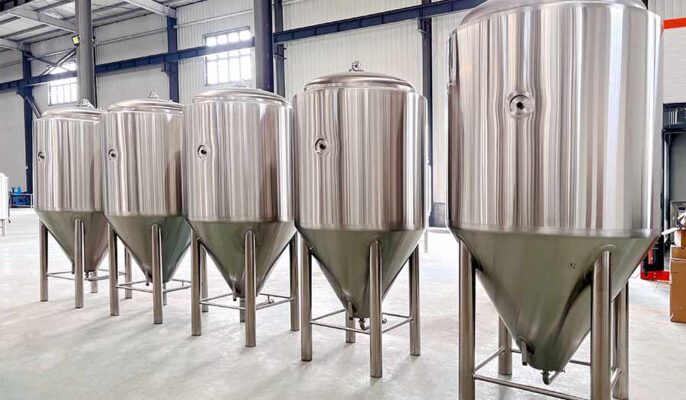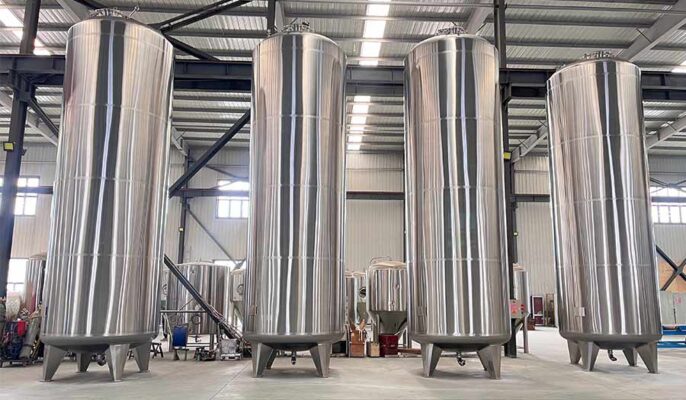Cerveza tanques de fermentación, or beer fermentation vessels, are essential equipment for fermentation in a brewery. The fermentation process not only affects the taste and flavor of the beer but also has a direct impact on productivity and product quality. The number of fermentation vessels required in a brewing system depends on several factors, including the size of the brewery, the type of beer you plan to produce, your production schedule, and the required fermentation capacity. Fermentation vessels are available in various sizes, and the size you need will certainly depend on the scope of the brewing operation. There are also several different types of fermentation vessels, so it’s important to choose the right one for your needs.
Visión general de Recipientes de fermentación
Fermentation vessels are used to store wort and ferment the wort into beer. Fermenters are an integral part of even the most modest home brewery. Almost any container that can hold liquid can be a potential fermenter. Different products can be fermented using different yeasts in the fermentation vessel. The use of brewer’s yeast allows for the fermentation of wort into beer. This is because the yeast converts sugar into alcohol during the fermentation process of making beer. You can also convert biomass into biogas in a fermentation vessel. It is important to note that an important factor in the fermentation process is the amount of oxygen. Without oxygen, the yeast will convert more sugar into alcohol. If there is too much oxygen, this will cause the yeast to multiply in the first place.

¿Cuántos recipientes de fermentación do I need for a complete brewing process?
Tamaño del lote
The capacity of each batch is the primary factor determining the number of fermentation vessels required. Generally, larger batches require more vessels, but this relationship is not always linear. Factors such as fermentation time, equipment cleaning and maintenance downtime, as well as required throughput, need to be considered. For instance, to maintain stable weekly production, you will need enough fermentation vessels to effectively stagger the production cycles.
Capacidad de producción
Determine how much beer you plan to produce within a given timeframe—weekly, monthly, or annually. Divide the total beer volume by the batch size to determine the number of batches needed. Knowing the average fermentation period for each type of beer is crucial in calculating production capacity.
To estimate the number of fermentation vessels needed, divide the expected output by the batch size. This will give you the minimum number of vessels required to meet your monthly production targets.
For example, if the expected monthly output is 4000 liters and the batch size is 1000 liters, you would need at least 4 fermentation vessels. However, it’s important to account for practical factors like maintenance, cleaning, and batch overlapping. Having additional vessels can help accommodate these factors and ensure smoother operations. It’s recommended to increase the number of fermentation vessels slightly above the minimum requirement to provide a buffer.
Fermentation Types and Specific Requirements
Each fermentation process has unique requirements. Whether it’s brewing beer, fermenting wine, producing vinegar, or fermenting dairy products, specific conditions such as temperature control, exposure to oxygen, or aging time are necessary. Understanding the complexity of your chosen fermentation type helps in selecting the appropriate number and type of fermentation vessels.
Estimated Fermentation Time
Managing multiple fermentations simultaneously affects the number of fermentation vessels required. Simultaneously handling different products or batches requires additional vessels and careful scheduling to prevent cross-contamination or interference between fermentations. Optimizing fermentation vessel use by staggering fermentations helps maintain a consistent production schedule.
If a product batch takes 10 days to ferment and your goal is to prepare a new batch every 10 days, you’ll need enough fermentation vessels to sustain this cycle. This may mean having 10 fermentation vessels so each batch can ferment independently without waiting for the previous batch to finish.
Flexibilidad y versatilidad
Consider using a mix of different-sized fermentation vessels to enhance operational flexibility. Smaller vessels can serve experimental batches, limited editions, or niche products, while larger vessels accommodate standard production runs and improve overall efficiency. This combination can adapt to market demands and allow for experimentation with new recipes.
Consider Overlapping Cycles
Efficient use of fermentation vessels involves overlapping fermentation cycles. While one batch is fermenting, another may be starting or finishing, minimizing downtime and maximizing output. Depending on fermentation times, effective cycle overlapping may reduce the number of vessels required compared to the number of batches produced.
Infrastructure and Space Limitations
Available space and infrastructure constraints may limit the number of fermentation vessels that can be accommodated in a specific area. Balancing operational efficiency with available space is crucial. Effectively utilizing existing infrastructure may involve investing in larger fermentation vessels or optimizing layouts to achieve better workflow. Ensure facilities meet safety and hygiene standards while considering potential future expansions.
Budget and Resource Allocation
Finally, budget constraints may impact the initial number of fermentation vessels you can acquire. Starting with a smaller number of multi-functional vessels and gradually scaling up based on production demands and financial capabilities may be feasible. Adjust your plans for the number of fermentation vessels based on budget constraints. Balancing the ideal number of fermentation vessels with financial considerations may require phased investments and prioritizing based on current needs. By carefully assessing batch dynamics, fermentation times, production scales, fermentation types, and flexibility requirements, you can tailor the fermentation vessel infrastructure to optimize efficiency and meet specific fermentation job requirements. Of course, you can also contact Micet Group, where engineers can tailor a solution that suits your needs.

How to choose the right size fermenter?
Materials of fermenter
When choosing a beer fermentation vessel, the material of the fermentation vessel is an important consideration. The most common materials used for beer fermentation tanks are stainless steel, aluminum, and plastic. Stainless steel is the most popular choice because it is durable, easy to clean, and does not react with beer. Aluminum is also a good choice because it is lightweight and affordable. Plastic tanks are cheaper than metal tanks, but they may not be as durable and can be difficult to clean.
Headspace
Headspace is the space at the top of the fermentation vessel that allows for expansion during fermentation. The amount of headspace required depends on the type of beer you brew and the fermentation process you use.
For example, beers that produce a lot of carbon dioxide during fermentation, such as ales, require more headspace to accommodate expansion. On the other hand, beers that produce less carbon dioxide, such as lagers, require less headspace.
Fermentation vessel shape
The shape and design of the fermentation vessel can also affect the fermentation process. Conical tanks are the most popular because they make it easy to collect yeast and other sediment during fermentation. However, other shapes, such as cylindrical, cylindrical, or square, may also be suitable depending on the specific needs of the brewery.
Presión nominal
The pressure rating of your fermentation vessel is another important consideration. Your fermenter should be able to withstand the pressure created during the fermentation process without compromising the integrity of the fermenter. Pressure ratings are usually measured in pounds per square inch (PSI), and your fermenter should be rated for the type of beer you want to produce.
Accesorios
The accessories that come with your fermentation vessel can also affect whether it is a good fit for your brewery. Some fermenters come with additional accessories like thermometers, pressure gauges, or sampling ports that can help monitor the fermentation process. Other accessories may include manholes for easy access to the fermenter, pipetting arms, or sight glasses.
Seek professional advice
If you are unsure which fermentation vessel is right for your brewery, it is best to consult a professional. Micet Group, for example, has engineers who can help you assess your specific needs and recommend the best solution for your operation.




